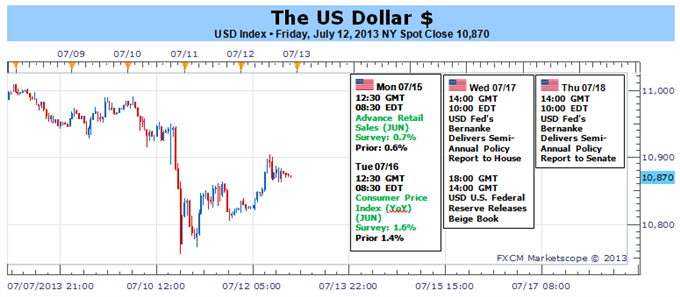
Dollar Versus S&P 500 as Bernanke Threatens Another Bolt of Volatility
Fundamental Forecast for US Dollar: Neutral
FOMC Minutes send markets reeling as ‘many’ want to see further jobs improvement before Taper
Fading demand at 3, 10 and 30-year Treasury auctions give clear Taper expectations
USDollar and S&P 500 correlation temporarily returns to normal, threatens currency turn
It was only a matter of time before the synchronized rally by the USDollar and S&P 500 suffered a fatality in the form of a reversal. However, it was unusual that the greenback was the end of the sentiment spectrum that would take the dive this past week. We need to ask whether this is just a temporary correction or the start of a meaningful fundamental shift. Has the Dow Jones FXCM Dollar Index (ticker = USDollar) topped out at its three-year highs at 11,000 and the EURUSD found a permanent bottom at 1.2750?
The first thing we must understand is why the simultaneous rally for the dollar and equities was so unusual. The S&P 500 is a benchmark for the US stock market – which is itself the preferred ‘high return’ asset for the average investor. That positions it firmly in the ‘risk on’ column. Alternatively, the greenback is the world’s most liquid currency and the preferred reserve asset for the largest central banks. That makes the dollar the ideal ‘safe haven’. In other words, these two should be at the opposite ends of the spectrum; and they should theoretically move in different directions with equal intensity.
And yet, the S&P 500 has extended its incredibly consistent bull trend from the past four years to fresh record highs while the dollar just recently marked its own three-year high. Some believe that this is a sign that the currency’s fundamental profile is changing; but in reality, it is more appropriately a result of risk trends losing their drive and the influence of stimulus taking its place. Unprecedented levels of QE from the Fed and other central banks has leveraged the historically, lightly traded equity market higher; while speculation of that programs eventual top and withdrawal has generated the greenback’s support. That leaves us with two critical dynamics to assess: the speculated time table of the Taper and bearings for risk appetite trends across the market.
This past week, thedollar and S&P 500 briefly returned to ‘normal’ – moving in opposite directions – because of a shift in stimulus expectations. While the seven-day rally for the equity index – only the third time in the past six years that we have seen a move of this magnitude – seems to suggest that the market’s are scrambling for all the return than can get their hands on, other markets didn’t support this suggestion. Carry trade levels were down, speculative commodity positioning is still heavily short and global equity markets were otherwise tepid or down. So, if it wasn’t a risk-based move; what sparks the volatility? Stimulus expectations.
Last week, the FOMC minutes and a speech by Fed Chairman Ben Bernanke hit the wires back-to-back. The market seemed to latch on to the note in the June meeting transcript that “many” officials believed that further employment was needed before they contemplated easing back the throttle on QE. After that, Bernanke’s remark of maintaining the ‘exceptionally accommodative’ stance can be interpreted as further evidence of a delayed Taper. Yet, the Chairman’s remarks are the same that have been used as reference for keeping the benchmark rate at or near zero for years. More importantly, the minutes also noted that‘more than half’ of the board could see QE3 ending by the end of the year. So why the selective interpretation? Heavy short-term speculative imbalance.
Heading into the new week, the equilibrium has tipped in the opposite direction. The burden is now with maintaining the belief that the Fed will not cut back its $85 billion-per-month-bond-purchase diet come September. It so happens that we have event risk that will challenge exactly that contentious point through the coming week. Aside from data (CPI, retail sales) and a few Fed speeches; the big ticket item is Bernanke’s congressional testimony on Wednesday and Thursday where he will undoubtedly be grilled on exactly this point. If he says anything that suggests the stimulus reductions can still begin in September, it could reverse this past week’s developments.
The ultimate escalation and inevitable conclusion of the Taper-debate though is the impact on risk trends. We have seen expectation of the pullback from the Fed impacting FX markets, treasuries and even foreign capital markets that are dependent on stimulus-backed risk appetite. Yet, the one glaring exception has been the US equity market. Moral hazard is deeply entrenched in the region and asset class, and it is difficult to shake. Yet, should this market collapse under its own weight; it will stand as the definitive sign of true and elemental risk aversion. Will we reach this level of fear in the coming week? Stimulus expectations, Chinese 2Q GDP and 2Q US earnings will tempt it. However, it is better as a trader to wait for confirmation rather than jump in too early. – JK
DailyFX provides forex news and technical analysis on the trends that influence the global currency markets.Learn forex trading with a free practice account and trading charts from FXCM.
Source: Daily fx